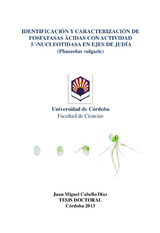Mostrar el registro sencillo del ítem
Identificación y caracterización de Fosfatasas ácidas con actividad 5'-Nucleotidasa en ejes de judía (Phaseolus vulgaris)
| dc.contributor.advisor | Pineda Priego, Manuel | |
| dc.contributor.advisor | Piedras Montilla, Pedro | |
| dc.contributor.author | Cabello Díaz, Juan Miguel | |
| dc.date.accessioned | 2013-05-21T11:41:06Z | |
| dc.date.available | 2013-05-21T11:41:06Z | |
| dc.date.issued | 2013 | |
| dc.identifier.uri | http://hdl.handle.net/10396/10147 | |
| dc.description.abstract | Las plántulas de judía (Phaseolus vulgaris) acumulan ureidos durante el desarrollo postgerminativo temprano, los cuales provienen de la degradación de nucleótidos de purinas. El primer paso de esta ruta está catalizado por una fosfatasa que transforma los nucleótidos en nucleósidos, enzima que hasta la fecha no ha sido identificada. En este trabajo se han identificado, purificado y caracterizado las dos actividades fosfatasas con masas moleculares de 55 y 100 kDa mayoritarias en ejes en desarrollo de judía. Ambas se inducen tras la germinación de las semillas y se diferencian por su sensibilidad al molibdato, un inhibidor de fosfatasas ácidas. La actividad de la proteína de 55 kDa fue resistente a molibdato y presentó mayor constante de afinidad por los nucleótidos. La actividad de 100 kDa fue sensible a molibdato y presentó mayor afinidad por fosfoenol piruvato, tirosina-P y pirofosfato. Ambas proteínas se han identificado mediante MALDI-TOF/TOF y la proteína de 55 kDa se ha expresado como proteína recombinante en Escherichia coli. Se han analizado las implicaciones fisiológicas de ambas actividades durante el desarrollo postgerminativo de judía y en plántulas expuestas a condiciones de estrés y se han relacionado con el contenido de ureidos en los mismos tejidos y condiciones. | es_ES |
| dc.description.abstract | After germination and during postgerminative development, common bean (Phaaseolus vulgaris) accumulates ureides derived from degradation of purines nucleotides. The first step in the conversion of purines to ureides is the removal of the 5´phosphate group by a phosphatase that has not been established yet. In this work two main phosphatase activities with molecular mass of 55 and 100 kDa were identified, purified and characterized in embryonic axes of common bean. Both activities were induced after radicle protrusion, and they differed in their sensibility to molybdate, a common phosphatase inhibitor. The enzyme of 55 kDa was resistant to molybdate and showed the highest phosphatase activity with the nucleotides as substrates. The enzyme of 100 kDa was sensitive to molybdate and showed the highest activity with phosphoenol pyruvate, tyrosine phosphate and pyrophosphate. A putative candidate gene coding for the enzyme of 55 kDa was cloned and overexpressed in Escherichia coli. The physiological implications for both activities and the ureides levels were analyzed during postgerminative development of common bean and in seedlings exposed to several stress conditions. | es_ES |
| dc.format.mimetype | application/pdf | es_ES |
| dc.language.iso | spa | es_ES |
| dc.publisher | Universidad de Córdoba, Servicio de Publicaciones | es_ES |
| dc.rights | https://creativecommons.org/licenses/by-nc-nd/4.0/ | es_ES |
| dc.subject | Judías | es_ES |
| dc.subject | Phaseolus vulgaris | es_ES |
| dc.subject | Nucleótidos | es_ES |
| dc.subject | Fosfatasa | es_ES |
| dc.subject | Desarrollo postgerminativo | es_ES |
| dc.subject | Ureidos | es_ES |
| dc.title | Identificación y caracterización de Fosfatasas ácidas con actividad 5'-Nucleotidasa en ejes de judía (Phaseolus vulgaris) | es_ES |
| dc.type | info:eu-repo/semantics/doctoralThesis | es_ES |
| dc.rights.accessRights | info:eu-repo/semantics/openAccess | es_ES |

